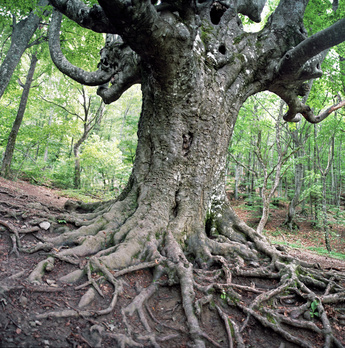Categories
Calendars
Guides
Reviews
Archive
Gallery
Articles
Ask Our Gardening Expert
Transplanting trees
Transplanting larger trees is much more difficult and may require expert help. Moving a tree is a large undertaking and should be carried out in stages after advance planning otherwise it may not adjust well to new surroundings.
The process should begin in the autumn of the year before the planned move, while the soil is still warm and the roots are active. Mark out the optimum root ball diameter for the tree, about one third of the tree height. A 3m tree should have a root ball of 1m diameter. Dig a trench of about 60cm deep and 30cm wide just outside the marked area and mix the excavated soil with large amounts of organic matter. Undercut the root ball as far as possible to sever any large roots and give the stem a ‘wrench’ by pulling it sideways in at least two directions. ‘Wrenching’ has the effect of encouraging new roots by breaking off smaller roots, stimulating fibrous root growth within the root ball. Replace the enriched trench material with a shovel or spade. These new roots can take up the unused resources closer to the tree, giving the tree time to adjust to its new site.
The following autumn, tie the large branches to the stem to allow a larger working space. Dig another similar trench outside the one made the year before and remove the soil until left with a manageable root ball, taking care not to damage fibrous roots. Cut through any remaining roots under the root ball to separate the tree from the surrounding soil. Pass some hessian or plastic sheeting under the root ball to hold it together and tie it around the stem. This will prevent the roots from drying out while it is being moved.
The tree is then taken to its new site. If the tree is small enough, it can be dragged or wheeled. Larger trees may need specialist lifting equipment. A hole the size of the root ball will have already been prepared. The tree is moved into the hole and the root covering taken from underneath. Soil from the hole is used to fill any remaining spaces around the root ball and is firmed in with the heel. The tree may need constant watering and mulching until it is well established.
If there is a danger, as with a large canopied tree or an exposed site, of the root ball moving and preventing the establishment of new roots. Staking or guy ropes may be necessary. Use two or three stakes outside the root ball with ties high enough to stabilise the tree but low enough to allow the stem to flex. Ties should be wide and soft and not of any material that could damage the bark. If wire guy ropes are used, they should be padded where they are in contact with the stem. Leave the supports in place a year or two and check for any movement or chafing damage from time to time. Slacken the ties around the trunk to allow for annual growth.
A garden tree may have grown too large for the site or it may be a precious specimen that needs to be preserved. Trees less than 2.5m present few problems but care still needs to be taken to be assured of their survival. 